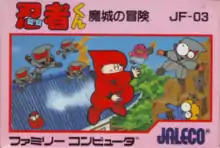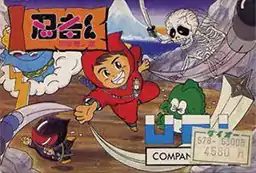Ninja-Kid
Ninja-kun: Adventure of Devil Castle (忍者くん魔城の冒険, Ninja-kun Ma-jō no Bōken) is the first video game in the Ninja-kun series. It was released for arcades, on the Famicom, and MSX by Jaleco in 1984.[1] The MSX version was the only version released outside of Japan, as it was released in Europe under the name "Ninja".[2]
| Ninja-kun: Adventure of Devil Castle | |
|---|---|
 Front cover of the Famicom version | |
| Developer(s) | UPL (Arcade) TOSE (FC) |
| Publisher(s) |
|
| Platform(s) | Arcade, Family Computer, MSX, Wii (Virtual Console) |
| Release | Arcade
|
| Genre(s) | Platform, action |
| Mode(s) | Single-player, multiplayer |
Gameplay
Ninja-kun's Demon Castle Adventure features three upward scrolling levels that repeat and become more difficult.[1] The objective is to defeat the enemies on each screen and advance to the next screen. The player can attack with shurikens and jump on enemies' heads to stun them. Occasionally, an orb will appear and if the player collects three, a bonus level will be unlocked.
Reception
In Japan, Game Machine listed Ninja-Kid on their November 15, 1984 issue as being the second most-successful table arcade unit of the year.[3]
Ninja-Kid II
| Ninja-Kid II (Rad Action) | |
|---|---|
 Front cover of the Famicom version. | |
| Developer(s) | UPL (Arcade) Micronics (FC) Opera house (MSX2) |
| Publisher(s) |
|
| Platform(s) | Arcade, Family Computer, MSX2, Wii (Virtual Console), PS4 |
| Release | 1987 |
| Genre(s) | Platform/action |
| Mode(s) | Single-player, multiplayer |

Ninja-Kid II, known in Japan as Ninja-kun Ashura no Shō (忍者くん阿修羅の章) and known in North America as Rad Action and JT-104, is a platform action video game first developed and published in 1987 by UPL in Japan. It is the direct sequel of Ninja-Kid. Game Machine listed Ninja-Kid II on their June 1, 1987 issue as being the tenth most-successful table arcade unit of the year.[4]
Legacy
After Jaleco had ported the game and its sequel to the Famicom and MSX in Japan, the company created Ninja-kun's younger brother, Ninja JaJaMaru-kun and created their own series titled Ninja JaJaMaru-kun.[1] The Ninja JaJaMaru-kun series would feature several games released on various consoles and handhelds, many of the games are different genres like role-playing video game gameplay.
References
- Kalata, Kurt. "Ninja JaJaMaru-kun". Hardcoregaming101. Retrieved 2010-02-27.
- "Ninja-kun - Magic Castle Adventure (1985, MSX, Jaleco, UPL), - Releases - Generation MSX". Retrieved 2020-05-15.
- "Game Machine's Best Hit Games 25 - テーブル型TVゲーム機 (Table Videos)". Game Machine (in Japanese). No. 248. Amusement Press, Inc. 15 November 1984. p. 25.
- "Game Machine's Best Hit Games 25 - テーブル型TVゲーム機 (Table Videos)". Game Machine (in Japanese). No. 309. Amusement Press, Inc. 1 June 1987. p. 21.
External links
- Ninja-Kid at the Killer List of Videogames
- Ninja-Kid II at arcade-history
- Rad Action at arcade-history
- Ninja-Kid (VC) HAMSTER page
- Ninja-Kid II (VC) HAMSTER page
- Ninja-Kid (PS4) HAMSTER page
- Ninja-Kid II (PS4) HAMSTER page
- "Ninja-Kid II game footage". Retrieved 2020-05-24.